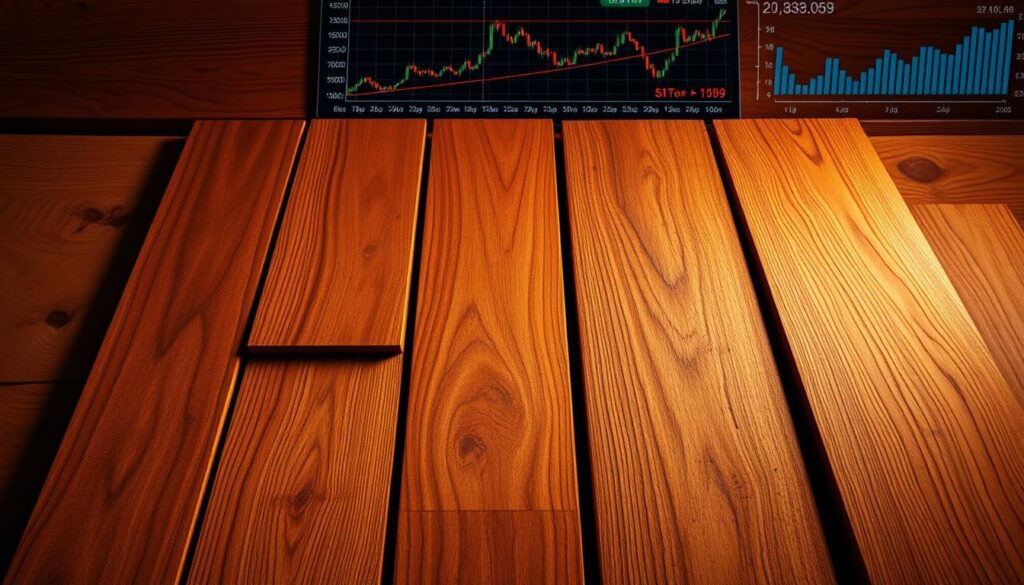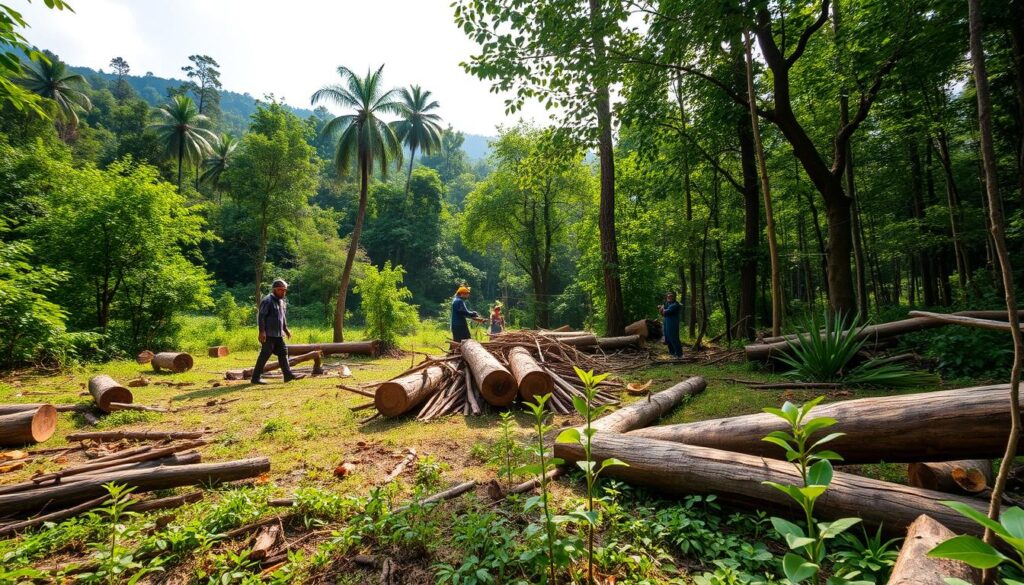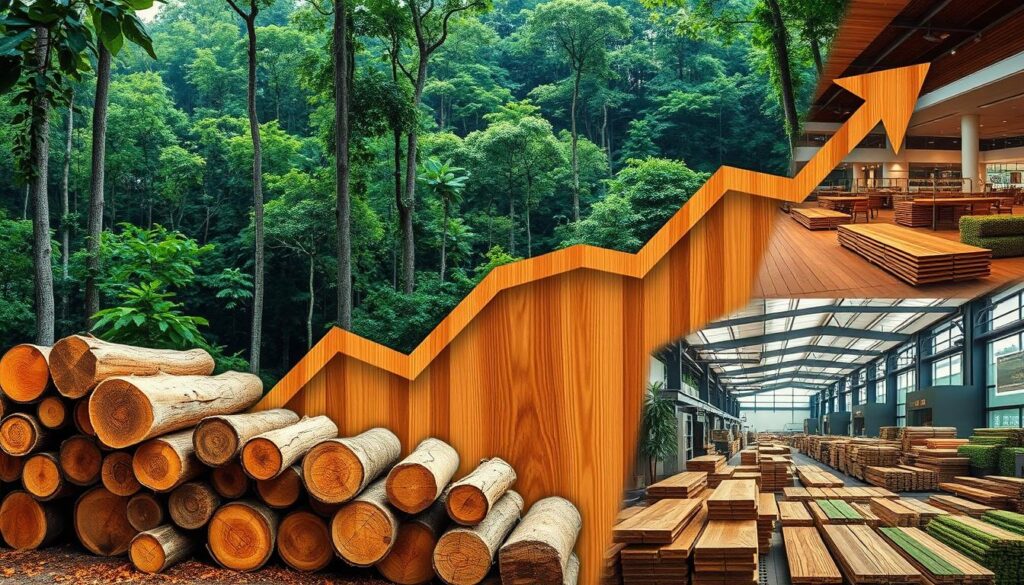Discover the latest teak wood rates and market insights to make informed purchasing decisions.
Knowing the latest teak wood prices is key for smart buying in the teak wood market. The industry’s complexity comes from many factors. These include supply and demand, production costs, and environmental issues. Keeping up with market trends is vital for everyone involved.
Market changes can greatly affect teak wood prices. This makes it hard to know the best time to buy or sell. Many things influence prices, like supply chain issues, where the wood comes from, and demand changes.

With the market always shifting, having the latest teak wood price and trend info is crucial. It helps you understand what affects prices. This includes the wood’s age and quality, processing costs, and demand shifts.
Key Takeaways
- Understanding current teak wood prices is crucial for making informed purchasing decisions
- Teak wood prices are influenced by factors such as supply and demand, production costs, and environmental considerations
- Staying up-to-date on teak wood market trends is essential for buyers, sellers, and investors
- Fluctuations in the market can significantly impact teak wood prices
- Access to current information on teak wood prices and market trends is essential for making informed decisions
- Teak wood market trends and prices are affected by various factors, including supply chain dynamics and geographic origin
Understanding the Global Teak Wood Market
The global teak wood market is complex and always changing. It’s shaped by many factors. Sustainable teak wood is in high demand, with teak wood suppliers working hard to keep up.
Places like Southeast Asia and Africa are key players in the market. They have many teak wood suppliers serving industries like construction and furniture. The way teak wood is supplied affects its quality, availability, and price.
Current Market Overview
There’s a big push for sustainable teak wood products now. This is because more people care about the environment and want green building materials. So, teak wood suppliers are focusing on sustainable forestry and getting certified.
Supply Chain Dynamics
The teak wood market’s supply chain involves many players. It’s important to understand this to keep the supply chain running smoothly. Teak wood suppliers face challenges like complex logistics and rules to get their products to customers.
Major Production Regions
Southeast Asia and Africa are the main places where teak wood is grown. They have the right climate and lots of land for growing teak. Sustainable teak wood farms in these areas are growing, offering a green timber option and helping fight deforestation.
Current Teak Wood Rate Analysis
Teak wood prices change due to many factors. These include production costs, market demand, and global economic trends. To understand these changes, a detailed market analysis is key.
Prices of teak wood have gone up over time. This is because of shifts in demand and supply.
Several factors impact teak wood prices. These are:
- Quality of the wood
- Geographic origin
- Market demand
- Global economic trends
The current teak wood prices are high. This is because of strong demand from construction and furniture industries. Yet, prices are expected to level out soon. This is as new plantations grow and production rises. Teak wood prices also depend on transportation, processing, and treatment costs.
Here’s a quick look at today’s teak wood prices:
| Grade | Price per board foot |
|---|---|
| High-quality | $10-$15 |
| Medium-quality | $8-$12 |
| Low-quality | $5-$8 |
Video source from Youtube
For buyers and sellers, a deep market analysis is vital. It helps them make smart choices. The current analysis shows the market is stable, with some ups and downs.
Factors Influencing Teak Wood Pricing
Several factors affect teak wood pricing. These include the wood’s age and quality, where it comes from, processing costs, and changes in market demand. The quality of the wood is a big factor, with older, better-quality teak costing more.
Age and Quality of Wood
The age and quality of teak wood greatly influence its price. Older, higher-quality teak is pricier because it lasts longer and resists rot and insects well.
Geographic Origin Impact
The place where teak wood comes from also matters. Some areas are known for better quality or more eco-friendly practices. For instance, teak from Indonesia is often seen as superior to that from other places.
Processing and Treatment Costs
How teak wood is processed and treated also affects its price. Wood that’s been kiln-dried or treated with preservatives costs more than untreated wood.
Market Demand Fluctuations
Changes in market demand also play a role in teak wood pricing. Prices go up when demand is high and down when demand is low.
| Factor | Impact on Price |
|---|---|
| Age and Quality of Wood | Higher quality teak wood is more expensive |
| Geographic Origin | Teak wood from certain regions is more expensive due to higher quality or sustainable practices |
| Processing and Treatment Costs | Teak wood that has been kiln-dried or treated with preservatives is more expensive |
| Market Demand Fluctuations | Prices increase during periods of high demand and decrease during periods of low demand |
Grading Systems and Their Impact on Price
Teak wood grading is key to determining its quality and price. The grading system looks at the wood’s color, grain, and durability. The FEQ (First European Quality) system is the most common. It categorizes teak wood based on quality and appearance.
The FEQ system has several categories, including:
- Grade A: High-quality wood with a straight grain and even color
- Grade B: Medium-quality wood with a slightly irregular grain and some color variation
- Grade C: Lower-quality wood with a more pronounced irregular grain and significant color variation
The price of teak wood greatly depends on its grade. Higher grades like Grade A cost more because of their superior quality and durability. For instance, Grade A teak wood is pricier than Grade C due to its higher quality.
The following table summarizes the different grades of teak wood and their corresponding prices:
| Grade | Price Range |
|---|---|
| Grade A | $50-$100 per board foot |
| Grade B | $30-$70 per board foot |
| Grade C | $20-$50 per board foot |
Knowing about teak wood grading and its price impact is crucial. It helps buyers make smart choices. By looking at the grade and quality, buyers can find the best value for their money.
Comparing Different Teak Wood Products and Their Costs
Teak wood is used in many ways, like furniture, building, and decorations. The price of teak wood items changes a lot. This depends on what it’s for, the wood’s quality, and how it’s made. For example, furniture-grade teak costs more than construction-grade teak because of the quality and making process.
The price of teak wood furniture varies a lot. It can be from a few hundred to thousands of dollars. This depends on the design, size, and wood quality. But, construction-grade teak is cheaper. It’s often used for outdoor things like decks and fences.
- Quality of the wood
- Production processes
- Market demand
- Intended use of the product
Knowing these points helps buyers make better choices. Whether it’s for teak wood furniture or construction-grade teak projects.
Sustainable Harvesting and Price Implications
The teak wood industry is moving towards sustainable teak wood harvesting. This means they focus on keeping teak wood supplies going for a long time. It also helps protect the environment. But, this shift comes with a cost, as sustainable teak wood might be pricier.
Several things affect the price of sustainably harvested teak wood. These include:
- Cost of certification and auditing
- Implementation of reforestation programs
- Use of environmentally friendly harvesting methods
Studies show that sustainable teak wood harvesting is good for both the industry and the planet. As more people care about the environment, they’ll want sustainable teak wood. This will make non-sustainable products more expensive.

In summary, sustainable teak wood harvesting is key in the teak wood industry. Its price implications are big. As the industry grows, sustainable teak wood will likely become the standard. This will help the environment and the industry greatly.
Where to Buy Teak Wood in the United States
Looking to buy teak wood in the United States? You have several options. You can find teak wood suppliers through retail stores, wholesale, and online marketplaces. Each choice has its own benefits and things to think about, based on what you need and like.
Home improvement stores and specialty lumber yards are great places to start. They have a variety of teak wood products like lumber, plywood, and decking. If you need a lot of teak wood, wholesale options are available. You can find them online or by contacting suppliers directly.
Online marketplaces are also a good choice. They offer a wide range of teak wood products, good prices, and easy shipping. Amazon and eBay are popular places to buy teak wood online.
When shopping online, make sure to check the seller and read reviews. This helps ensure you’re buying from a trusted supplier and getting quality teak wood. By exploring these options and doing your homework, you can find the perfect place to buy teak wood for your needs.
| Option | Benefits | Considerations |
|---|---|---|
| Retail Outlets | Convenient, variety of products | Higher prices, limited quantities |
| Wholesale Options | Lower prices, larger quantities | Requires larger upfront investment |
| Online Marketplaces | Convenient, competitive pricing | Must research seller, potential shipping issues |
Future Market Predictions and Trends
The teak wood market is set to change due to global demand, environmental worries, and economic shifts. Looking ahead, teak wood market trends will be influenced by a growing need for eco-friendly products and concerns over supply chain issues. The industry must adapt to these changes to stay competitive.
Some key future predictions for the teak wood market include:
- Growing demand for sustainable and responsibly sourced teak wood products
- Increased focus on certification and verification of sustainable forestry practices
- Supply chain disruptions due to environmental and economic factors
Experts say the teak wood market will have to balance quality product demand with environmental protection. This will need new solutions and strategies to handle the complex teak wood market trends and future predictions.

Looking to the future, future predictions will be crucial for the teak wood market’s direction. By understanding and adapting to these trends, both buyers and sellers can make smart choices in the teak wood market.
Conclusion: Making Informed Teak Wood Purchasing Decisions
Making smart choices in the teak wood market means knowing the current prices and trends. This article has given you key insights into the teak wood industry. It shows how important quality, sustainability, and market trends are when buying.
When you’re looking at teak wood, look for certifications and traceability. This helps ensure the wood is harvested responsibly. Also, keep an eye on industry forecasts and new trends. This way, you can make the best choices and get great value for your money. By being informed, you can find teak wood that meets your needs and helps the environment.
FAQ
What is the current state of the global teak wood market?
The global teak wood market is complex. Many factors affect supply and demand. Recent trends, challenges, and opportunities have shaped it.
Supply chain dynamics and major production regions, mainly in Southeast Asia and Africa, play key roles.
What factors influence the pricing of teak wood?
Several factors affect teak wood pricing. These include the wood’s age and quality, its origin, processing costs, and demand changes. These elements greatly influence the final cost.
How do grading systems impact the price of teak wood?
Grading systems are crucial for teak wood quality and price. Different systems have specific criteria. Higher grades, with better quality and durability, cost more.
How do the costs of different teak wood products compare?
Teak wood product costs vary by use. Furniture-grade, construction-grade, and decorative products have different prices. This is due to wood quality, production, and demand.
How do sustainable harvesting practices affect the price of teak wood?
Sustainable harvesting can impact teak wood prices. Certified sustainable wood may cost more due to sustainable forestry costs. Yet, the long-term benefits for the industry and environment are significant.
Where can teak wood be purchased in the United States?
Teak wood is available in the U.S. through retail, wholesale, and online. Each option has its benefits and considerations. Buyers should consider their needs and preferences.
What are the future market predictions and trends for teak wood?
The teak wood market will evolve due to global demand, environmental concerns, and economics. Challenges like supply chain disruptions and opportunities like sustainable demand will shape the future. Adaptation will be key for both buyers and sellers.
Related article : Can You Stain Teak Wood? Learn the Best Methods
